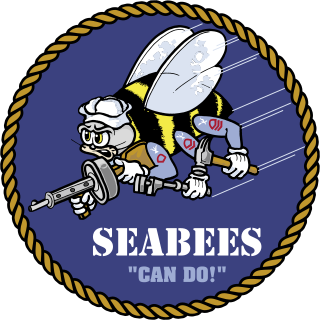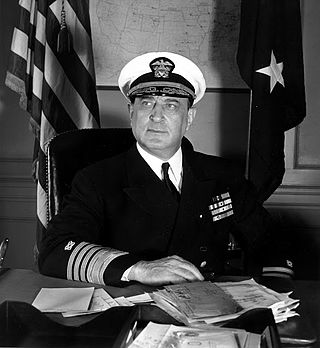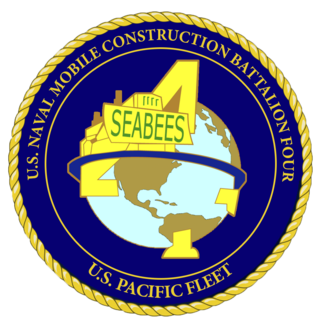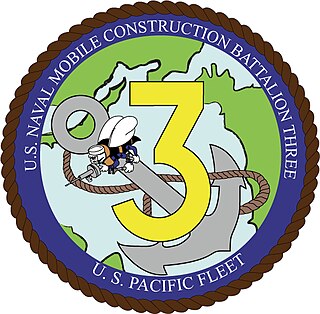
United States Naval Construction Battalions, better known as the Navy Seabees, form the U.S. Naval Construction Force (NCF). The Seabee nickname is a heterograph of the initial letters "CB" from the words "Construction Battalion". Depending upon context, "Seabee" can refer to all enlisted personnel in the USN's occupational field 13 (OF-13), all personnel in the Naval Construction Force (NCF), or Construction Battalion. Seabees serve both in and outside the NCF. During World War II they were plank-holders of both the Naval Combat Demolition Units and the Underwater Demolition Teams (UDTs). The men in the NCF considered these units to be "Seabee". In addition, Seabees served as elements of Cubs, Lions, Acorns and the United States Marine Corps. They also provided the manpower for the top secret CWS Flame Tank Group. Today the Seabees have many special task assignments starting with Camp David and the Naval Support Unit at the Department of State. Seabees serve under both Commanders of the Naval Surface Forces Atlantic/Pacific fleets as well as on many base Public Works and USN diving commands.

The Seabee Combat Warfare Specialist (SCWS) insignia is a warfare qualification of the United States Navy.

Admiral Ben Moreell was the chief of the U.S. Navy's Bureau of Yards and Docks and of the Civil Engineer Corps. Best known to the American public as the father of the Navy's Seabees, Moreell's life spanned eight decades, two world wars, a great depression and the evolution of the United States as a superpower. He was a distinguished naval officer, an engineer, an industrial giant and a national spokesman.

The Civil Engineer Corps (CEC) is a staff corps of the United States Navy. CEC officers are professional engineers and architects, acquisitions specialists, and Seabee Combat Warfare Officers who qualify within Seabee units. They are responsible for executing and managing the planning, design, acquisition, construction, operation, and maintenance of the Navy's shore facilities. The Civil Engineer Corps is under the command of the Chief of Civil Engineers and Commander, Naval Facilities Engineering Systems Command. On 12 August 2022, RADM Dean VanderLey relieved RADM John W. Korka, becoming the 46th commander of NAVFAC and Chief of Civil Engineers.

Rear Admiral Jay Allan DeLoach served as the Director of Naval History and Director of the Naval History and Heritage Command and the Curator of the Navy from 2008 to 2012. He was an American submarine officer who played a role in implementing a visionary "Memorandum of Understanding" between the Submarine Force Active component and the Reserve component. He helped pioneer many key initiatives that have since been adopted Navy-wide. DeLoach was the Assistant Deputy Chief of Naval Operations for Resources, Requirements and Assessments.
Hispanic and Latino Admirals in the United States Navy can trace their tradition of naval military service to the Latino sailors, who have served in the Navy in every war and conflict since the American Revolution. Prior to the Civil War, the highest rank reached by a Latino-American in the Navy was commodore. Such was the case of Commodore Uriah Phillips Levy (1792–1862), a Sephardic Jew of Latin American descent and great grandson of Dr. Samuel Nunez, who served in the War of v. During the American Civil War, the government of the United States recognized that the rapid expanding Navy was in need of admirals therefore, Congress proceeded to authorize the appointment of nine officers the rank of rear admiral. On July 16, 1862, Flag Officer David Glasgow Farragut became the first Hispanic-American to be appointed to the rank of rear admiral. Two years later (1864), Farragut became a vice admiral, and in 1866 the Navy's first full admiral. During World War I, Robert Lopez, the first Hispanic graduate of the United States Naval Academy, served with the rank of commodore in command of the Mare Island Naval Shipyard, and during World War II five Hispanics served with the ranks of rear admiral or above in either the European or Pacific Theaters of the war. As of April 2007, twenty-two Hispanic-Americans have reached the rank of admiral, and of this number thirteen were graduates of the USNA.

Lewis Barton Combs was a United States Admiral who helped found and direct the famed "Seabees" construction battalions in World War II.

Naval Mobile Construction Battalion 4 is a Navy Seabee battalion homeported at Port Hueneme, California. Nicknamed the "Pioneers", it is the first of the many CBs created after the original three. The Battalion's current insignia first appeared on its 1953–55 cruisebook.

Arthur William Fort was United States Assistant Secretary of State for Administration from 1989 to 1993. Trained in civil engineering and construction management, Fort was recognized for his efforts to modernize U.S. embassy facilities.

Rear Admiral Katherine Louise Gregory is the first female flag officer in the United States Navy Civil Engineer Corps (CEC). She assumed command of Naval Facilities Engineering Command (NAVFAC) Pacific on July 9, 2010, and took command of all NAVFAC as the highest-ranked civil engineer in the navy in 2012. In November 2015, RADM Gregory was succeeded by RADM Bret J. Muilenburg.

Naval Mobile Construction Battalion THREE is a United States Navy Seabee that was one of the three original Construction Battalions authorized to be formed in 1942. In May 1942 Naval Construction Battalion 3 deployed to the Territory of Hawaii and designated Brigade Headquarters Battalion for the Hawaiian Area NCF. After seeing service in the south Pacific,the battalion was decommissioned mid-1944. In 1950 the battalion was reactivated and today is home-ported at Port Hueneme, California.

Naval Mobile Construction Battalion FORTY, nicknamed Fighting FORTY, was a US Navy Seabee Battalion based out of Port Hueneme, California. Its primary mission was wartime contingency construction as well as peacetime construction and disaster relief.

Naval Mobile Construction Battalion 133 is a United States Navy Construction Battalion, otherwise known as a Seabee Battalion, homeported at the Naval Construction Battalion Center. The unit was formed during WWII as the 133rd Naval Construction Battalion. It saw action and was decommissioned shortly after the war ended. The unit was reactivated as Mobile Construction Battalion 133 for the Vietnam War and remains an active unit today.

Naval Mobile Construction Battalion SEVEN (NMCB 7) was a Navy Seabee battalion last homeported at Naval Construction Battalion Center, Gulfport Mississippi. Nicknamed the "Magnificent Seven", it is one of the first ten Naval Construction Battalions formed by the U.S. Navy in 1942.

Naval Mobile Construction Battalion TWO SIX was a United States Navy Seabee battalion commissioned in 1942 for support to Naval Operations in the Pacific Theater in World War II and later a Reserve Naval Construction Battalion based in various locations in the Midwest from 1962 until 2014.

Naval Mobile Construction Battalion 25 or NMCB 25 is a Navy Reserve Seabee unit that is headquartered at Port Hueneme, CA. Its World War II predecessor was one of three CBs transferred to the Marine Corps in the late summer of 1942 as combat engineers. Those three battalions were attached to composite Marine Engineer Regiments as the third battalion of their respective regiment. All of them remained with the Marine Corps for the next two years before they were released and returned to the Navy. At the end of World War II the battalion was decommissioned. In 1961, it was recommissioned in the Naval Construction Force Reserve where it remains today.

Naval Mobile Construction Battalion 11 is a United States Navy Construction Battalion, otherwise known as a Seabee Battalion, presently home-ported at the Naval Construction Battalion Center. The unit was formed during World War II as the 11th Naval Construction Battalion at Camp Allen on 28 June 1942. On 1 July, she moved to the new Seabee base Camp Bradford. Seabee battalions were numbered sequentially in the order they were stood up. The battalion lost one man during the war to a construction accident. The 11th CB was inactivated on 1 December 1945, at Subic Bay, Philippines.

Naval Construction Battalion 5 was commissioned on May 25, 1942 at Camp Allen Va. The battalion went to Port Hueneme and shipped out for the first of two deployments in the Pacific. When the war ended CB 5 was decommissioned in the Philippines. On July 10, 1951 the Battalion was re-commissioned as a MCB and remains an active unit today.

Benjamin Franklin Montoya was a United States Navy rear admiral. He served as commanding officer of Naval Facilities Engineering Command from 1987 to 1989. Montoya was the first Hispanic chief of naval civil engineers.


















